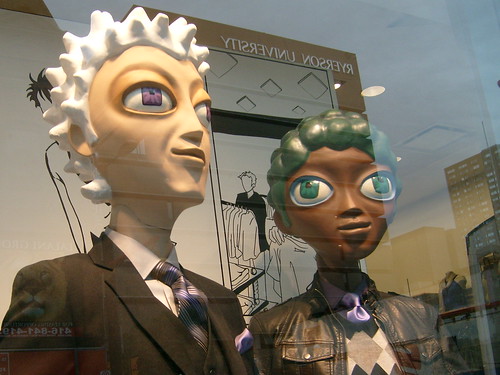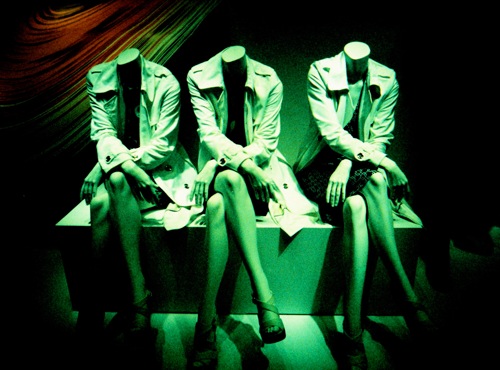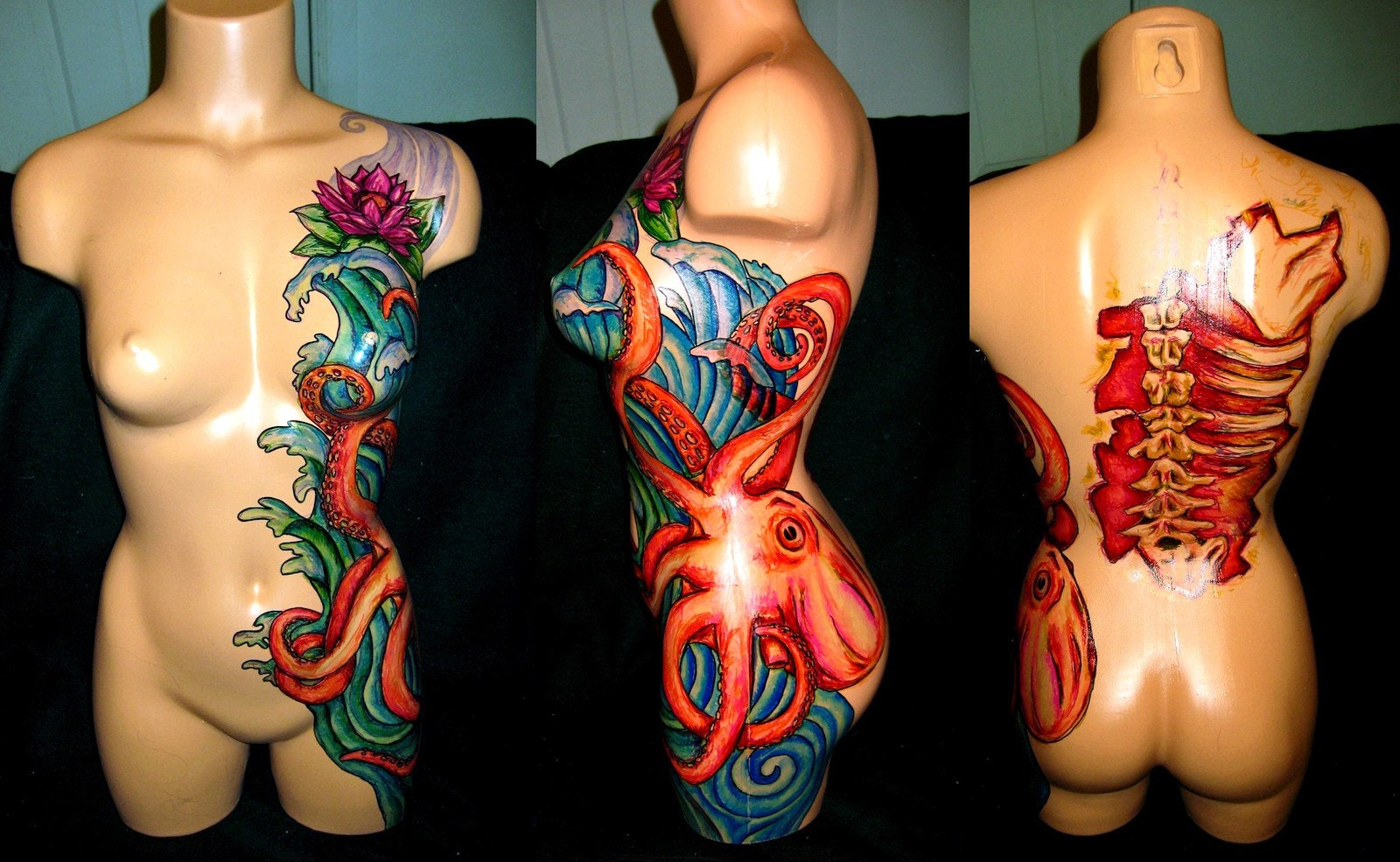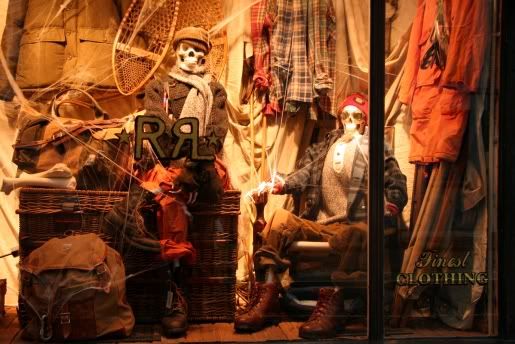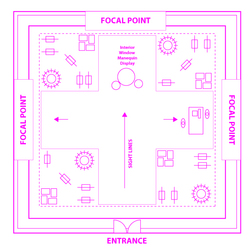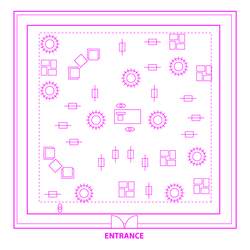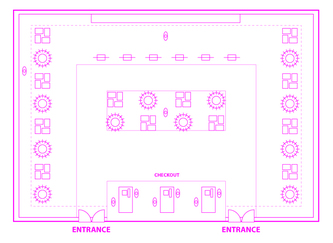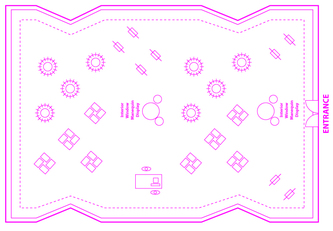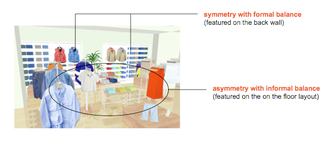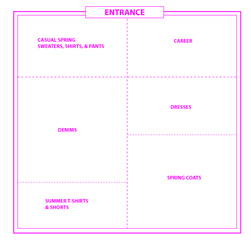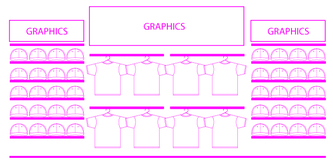Window Display

Thursday, February 27, 2014
Mannequins
QUIZLET!
"The selection of a mannequin is probably one of the most important professional decisions a display person is called upon to make.:
• Silent Spokesperson
• must be carefully maintained
• given time off
• purchase additional accessories
Types of Mannequins
Realistic Mannequins
• formerly like movie stars, now more like the person on the other side of the glass.
• tanner in the South and West
• frequently fuller figured
• make-up and wig styles can target particular customers
• pose can suggest and support type of merchandise - formal, tailored, sporty
• bent arms are dynamic, but difficult to dress
• horizontal mannequins
Because mannequins are expensive and usually only in fashion for a year or two, smaller retail stores limit their purchase to two or three,
• Does this form represent your target market?
• Will your customer "relate" to "her?
• Is she shaped and proportioned to wear the type of garments you show?
•Does she make the kind of fashion statement your store wants to make?
Types of Realistic Mannequins
Missy Size
• Size 4-8, 5'8" to 6' tall, 35-25-35, size 6 to 8 shoe
Junior Mannequin
• Size 5, 5'7"to 5'9", 32-22-32
Junior Petite/Petite Mannequins
• 5' to 5'4", Size 4-6, 32-22-32
Full Figured Mannequin
• Size 14
Preteen Mannequin
Male Mannequin
Child Mannequin
Accessories include arms, legs, wigs, makeup or glass eyes
Semi Realistic Mannequins
• sculpted like realistic but more decorative and stylized
Semi Abstract Mannequins
• no real features, often no hair - doll-like and decorative
Abstract Mannequins
Cartoon Mannequins
Headless Mannequins
Alternatives to Mannequins
Three Quarter Form
• a body extending from shoulder to knees
• headless 3/4 form is called a Torso Form
Other Forms
Body Trunk or Trunk Form
• chest to knees
Bra Form
• chest form
Bust, Blouse, Shirt or Sweater Form
• armless, headless, end just below waistline
Coat or Suit Form
• headless male form that ends around the hips
Pants Form
• waist to ankle
Panty Form
• waist to knees
Pantyhose Form
• legs
Shell Form
• half round bust form
Stocking Form
• single legs
Soft Sculpted Figures
Articulated Artist Figures
Dress and Suit Forms
Cutout Figures
Inflatables
Drapers
Hangers
Lay Down Techniques
Pin-ups Techniques
Flying Techniques
HOMEWORK:
Digital Sketchbook - You are going to begin designing your own store!
1. Start a Pinterest board called "Store Project."
2. Begin to collect images for inspiration. Your board should have at least 7 images.
3. One image be of the kind of mannequins that you'll be using in your store.
4. Write a paragraph about your store's look, your customer and the kind of clothes that you will carry. The paragraph should be typed and ready to hand in.
Due Tuesday, March 4th.
There will be a Quiz on Mannequins, also on Tuesday, March 4th.
READ: Chapters 9 and 10
Tuesday, February 25, 2014
How to make a digital portfolio
Your class blog will serve as a digital portfolio. It will be a place to showcase your work.
Step by Step Instructions on Creating a Blog
• Go to www.blogger.com
• Click on the red "SIGN UP" button
• Fill out your information.
When you pick a username it will become a new gmail address for you. Choose something that relates to, or is, your name.• You can add a profile picture or just click "Next step"
• Click "Back to Blogger"
• Click "Continue to Blogger"
• Click "New Blog"
• Choose a Title (it can be your name if you like) and a url that is easy to remember. Select a Template, then click "Create blog!"
There you go! You have created a blog.
To Customize and add the Followers feature:
• Click on the Blog Title to go to the dashboard
• Click "Layout"
• Click "Add a Gadget"
• Scroll down the list of gadgets and click on the "+" button next to Followers
This will put the "Sign up" button on your page and enable people to easily follow your blog.Take some time to explore the options on your dashboard. You can change the basic Template, add other gadgets or change the colors of your background!
HOMEWORK: Create a blog by Thursday. Upload your homework - floor plan and picture of mood board.
Tuesday, February 18, 2014
Store Design and Floor Plans
Examples of Fabulous Floor Plans
The Psychology of Store Design
http://www.homestyler.com/ online drawing software
Function of the Store Planner
1. To design an efficient and attractive selling environment to maximize sales2. To combine selling space with "back of the house" areas
3. To set up traffic patters that will promote customer movement
4. To promote and sell. To stock and show
5. To enhance the store's image
TO DIRECT THE SHOPPING DRAMA!
Rehabilitations
Floor Plans
Visual Merchandising + Store Planning + Retail Design
Floor Plans + Space Planning
How you
layout your store is also a form of visual merchandising, it helps
people navigate but it can also create good buying habits. A floor plan
must be made with both the shopper and the marketing plan in mind. Who
is going to shop your store? What are you going to carry? How will you
restock your shelves? Do you need to be sensitive to seasonal changes?
These are just some of the questions that you need to answer. Everything
hinges on your ability to clearly identify your target and your mission
after which most questions and problems will answer themselves. Review
the floor plan layout strategies here to help you decide which one best
meets your
target customers needs.
target customers needs.
Grid floor plans
Grid
layouts are linear designs with fixtures arranged on parallel isles.
Fixtures are often positioned in a checkerboard pattern, with vertical
and horizontal aisles that run throughout the store. This is a simple
and efficient use of space and creates natural sight lines typically
seen in men’s stores. *(Click on image to enlarge)
Free flow floor plans
Free-flowlayouts
are arranged to encourage a feeling of browsing and the thrill of the
hunt. It is sort of like creating little mini areas of interest within
the floor plan as a whole. A major concern though is allowing enough
room for browsing and still maintaining a sense of some order. This sort
of layout is typically seen in a woman's boutique as women generally
like the thrill of the hunt. *(Click on image to enlarge)
Loop floor plan
Loop
layouts feature a race track like feel. This is usually very effective
in a larger off price or discount stores. It allows for maximum
merchandise to be seen and browsed effectively and offers the retailer
to build on products as customers move ahead. *(Click on image to
enlarge)
Soft isle floor plan
Soft isle
layouts use arranged fixtures into groups, with 5 foot aisle along the
merchandise wall sections. This technique encourages customers to shop
the walls and to move easily around the entire store. Walls are
considered to be the most important sales generating locations in the
store layout strategy. You see this sort of approach used in sporting
goods stores as men need more obvious visual cues to motivate them to
shop. *(Click on image to enlarge)
Space Planning
Good
merchandisers can often employ several layers of techniques to create a
truly great use of space, and still stayed focused on the bottom of line
of sales. The merchandise you sell is an important consideration. How
will they first see it? How will the customer need to interact with it?
How do you want them to interact with it?
Using Symmetrical and Asymmetrical approaches
Creating
creative visual merchandising that engulfs the viewer is a multilevel
task. Consider the example below from www.techexchange.com it at once
utilizes a symmetrical approach on the back wall and a nicely balanced
asymmetrical floor plan in front. This technique is employed by
virtually all of the big chain clothing stores such as the Gap, Macy's,
and H&M. *(Click on image to enlarge)
Adjacencies
This
rather simple strategy is often forgotten by smaller retailers.
Adjacencies used properly can give you add on sales and aid in cross
merchandising. More importantly it can help get the customer past the
front door. Remember to group things together that have an obvious
connection. *(Click on image to enlarge)
Using a Plan-o-gram
A
plan-o-gram is a useful communication tool. Using a plan-o-gram layout
like the one shown here allows you to visually refer to something when
trying to develop a strategy. This visual reference point is a good way
to effectively communicate with both your department managers and
employees as to what your goals are.
*Notice how there is an effective mix of both fixture hardware, graphics, and props all working together to further the “sports team” theme. This sort of layout would be seen in a sporting goods store like say Models and would be used with a soft isle layout. *(Click on image to enlarge)
*Notice how there is an effective mix of both fixture hardware, graphics, and props all working together to further the “sports team” theme. This sort of layout would be seen in a sporting goods store like say Models and would be used with a soft isle layout. *(Click on image to enlarge)
• a flat representation viewed from above
• drawn to scale
HOMEWORK: By hand OR using software, create a store plan for your store. Think about traffic and merchandising!
Read: Chapter 25
Tuesday, February 11, 2014
HOMEWORK POST
HOMEWORK:
You may work alone or with a partner.
Choose an existing store. Write on paragraph talking about the brand - what kind of customer shops there? What look are they going for?
Create a two board presentation. On board will feature mood and concept images. On the second board, please draw a floor plan and color story for the store.
The MOOD BOARD IS DUE - Thursday, February 20th.
Read Chapters 5 and 8 in the text. There will be quizzies!
Examples
EXAMPLES:
J. Crew
Forever 21
Priscilla of Boston
LINK to 3-D layout
DSW Shoes
- Aerosoles
Marimacho Inc.
 |
Subscribe to:
Posts (Atom)



